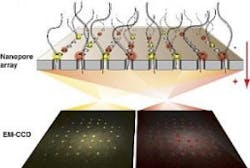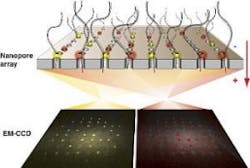Optical detection method could reduce human genome sequencing cost
A team led by Boston University (BU) biomedical engineering researchers has won a $4.1 million, four-year grant from the National Institutes of Health (NIH) to refine its nanoscale, low-cost, ultra-fast DNA sequencing method that could lead to individual genome sequencing for less than $1,000. Led by BU Biomedical Engineering Professor Amit Meller, the team has already demonstrated the first use of solid-state nanopores to optically sequence the four nucleotides that encode each DNA molecule using a high-speed CCD camera, said Meller. Using this method to detect single DNA molecules in nanopores could significantly reduce the cost of DNA sequencing and the time required to sequence a complete human genome.
Combining optical detection capability with the ability to analyze extremely long DNA molecules with superior sensitivity, the team's solid-state nanopores are uniquely positioned to compete with current, third-generation DNA sequencing methods for cost, speed and accuracy. Unlike those approaches, the new nanopore method does not rely on enzymes whose activity limits the rate at which DNA sequences can be read; instead, readout speed is restricted only by current optical detection limits.
"This puts us in the unique, advantageous position of being able to claim that our sequencing method is as fast as the rapidly evolving CCD/CMOS technologies," said Meller. "We currently have the capability of reading out about 100 bases per second, which is already much faster than other commercial third-generation methods. This is only the starting point for us, and we expect to significantly increase this rate in the next year."
Licensing intellectual property from Boston University and Harvard University, Meller and his collaborators founded NobleGen Biosciences last February to develop and commercialize nanopore sequencing based on the new method. Researchers from the University of Massachusetts Medical School in Worcester are also working on the current project.
"Given the aggressive research and development effort that's now underway, I estimate that it will take less than five years to bring a highly competitive and cheap DNA sequencing to the medical marketplace," said Meller.
Since its founding in 2004, the $1,000 Genome program has produced innovations that have reduced the cost of genome sequencing from $10 million to $20,000, and cut the time needed to complete the process from a few months to a week. The BU project is one of 10 to receive funding from the NIH National Human Genome Research Institute (NHGRI) this year under its "Revolutionary Sequencing Technology Development—$1,000 Genome" program. The new NHGRI awards were announced this week.
Source: Boston University College of Engineering
Posted by Lee Mather
Subscribe now to BioOptics World magazine; it's free!

